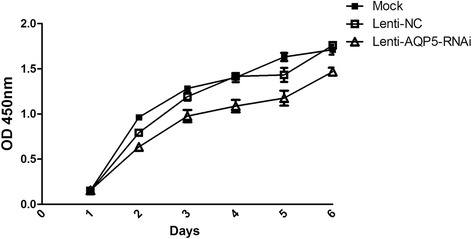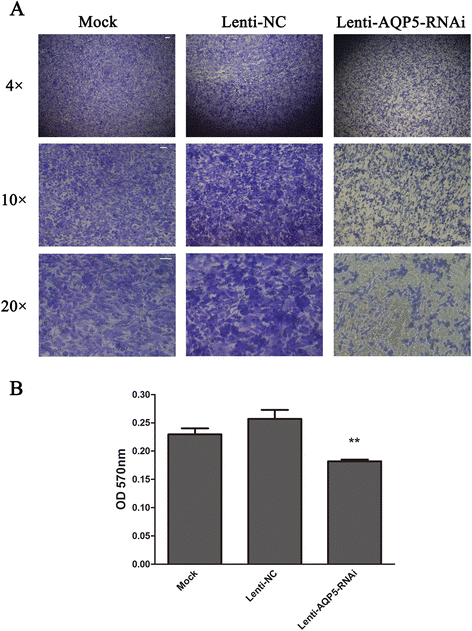Down-regulated aquaporin 5 inhibits proliferation and migration of human epithelial ovarian cancer 3AO cells
- PMID: 25298246
- PMCID: PMC4164796
- DOI: 10.1186/s13048-014-0078-2
Down-regulated aquaporin 5 inhibits proliferation and migration of human epithelial ovarian cancer 3AO cells
Abstract
Background: Recent studies suggested that aquaporins 5 (AQP5) was associated with many kinds of cancers and regulated many processes of various kinds of cancer cells. Our previous studies also demonstrated that AQP5 was highly expressed in epithelial ovarian cancer and contributed to the progress of ovarian cancer.
Methods: Lentivirus for knocking-down the expression of AQP5 was prepared and verified by qPCR and Western blotting. Cell counting kit-8 (CCK8) assay and transwell assay were performed to investigate the role of AQP5 on proliferation and migration of 3AO cells. The effects of down-regulating AQP5 on tumorigenesis were tested by tumor xenografts experiments.
Results: An effective lentivirus silencing AQP5 expression was obtained and used in this study. Down-regulating AQP5 inhibited proliferation and migration of cultured human epithelial ovarian cancer 3AO Cell. Furthermore, interfering of AQP5 during tumorigenesis could efficiently decrease the tumor growth in athymic mice.
Conclusions: These findings altogether suggest that AQP5 regulated multi processes in ovarian carcinogenesis and may be an attractive therapeutic target.
Figures




Similar articles
-
[AQP5 gene silencing inhibits proliferation and migration of ectopic endometrial glandular epithelial cells in endometriosis].Zhejiang Da Xue Xue Bao Yi Xue Ban. 2015 May;44(3):285-92. doi: 10.3785/j.issn.1008-9292.2015.05.08. Zhejiang Da Xue Xue Bao Yi Xue Ban. 2015. PMID: 26350009 Free PMC article. Chinese.
-
Aquaporin 5 expression is altered in ovarian tumors and ascites-derived ovarian tumor cells in the chicken model of ovarian tumor.J Ovarian Res. 2014 Oct 25;7:99. doi: 10.1186/s13048-014-0099-x. J Ovarian Res. 2014. PMID: 25344048 Free PMC article.
-
Aquaporin-5: a marker protein for proliferation and migration of human breast cancer cells.PLoS One. 2011;6(12):e28492. doi: 10.1371/journal.pone.0028492. Epub 2011 Dec 1. PLoS One. 2011. PMID: 22145049 Free PMC article.
-
Aquaporin-5 in breast cancer.APMIS. 2022 May;130(5):253-260. doi: 10.1111/apm.13212. Epub 2022 Feb 28. APMIS. 2022. PMID: 35114014 Free PMC article. Review.
-
Aquaporin-5: from structure to function and dysfunction in cancer.Cell Mol Life Sci. 2016 Apr;73(8):1623-40. doi: 10.1007/s00018-016-2142-0. Epub 2016 Feb 2. Cell Mol Life Sci. 2016. PMID: 26837927 Free PMC article. Review.
Cited by
-
Identification of lncRNAs Deregulated in Epithelial Ovarian Cancer Based on a Gene Expression Profiling Meta-Analysis.Int J Mol Sci. 2023 Jun 28;24(13):10798. doi: 10.3390/ijms241310798. Int J Mol Sci. 2023. PMID: 37445988 Free PMC article.
-
Identification of EMT-Related Gene Signatures to Predict the Prognosis of Patients With Endometrial Cancer.Front Genet. 2020 Dec 2;11:582274. doi: 10.3389/fgene.2020.582274. eCollection 2020. Front Genet. 2020. PMID: 33343628 Free PMC article.
-
RBP4 regulates trophoblastic cell proliferation and invasion via the PI3K/AKT signaling pathway.Mol Med Rep. 2018 Sep;18(3):2873-2879. doi: 10.3892/mmr.2018.9240. Epub 2018 Jul 3. Mol Med Rep. 2018. PMID: 30015949 Free PMC article.
-
Aquaporin 5 promotes corneal wound healing.Exp Eye Res. 2018 Jul;172:152-158. doi: 10.1016/j.exer.2018.04.005. Epub 2018 Apr 13. Exp Eye Res. 2018. PMID: 29660329 Free PMC article.
-
Ganoderic acid A inhibits proliferation and invasion, and promotes apoptosis in human hepatocellular carcinoma cells.Mol Med Rep. 2017 Oct;16(4):3894-3900. doi: 10.3892/mmr.2017.7048. Epub 2017 Jul 21. Mol Med Rep. 2017. PMID: 28731159 Free PMC article.
References
-
- Yurkovetsky Z, Skates S, Lomakin A, Nolen B, Pulsipher T, Modugno F, Marks J, Godwin A, Gorelik E, Jacobs I, Menon U, Lu K, Badgwell D, Bast RC, Jr, Lokshin AE. Development of a multimarker assay for early detection of ovarian cancer. J Clin Oncol. 2010;28:2159–2166. doi: 10.1200/JCO.2008.19.2484. - DOI - PMC - PubMed
Publication types
MeSH terms
Substances
LinkOut - more resources
Full Text Sources
Other Literature Sources
Medical

